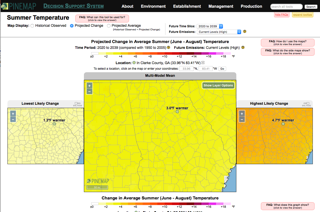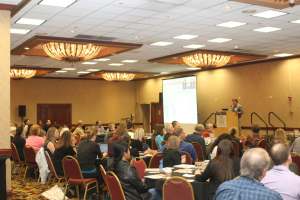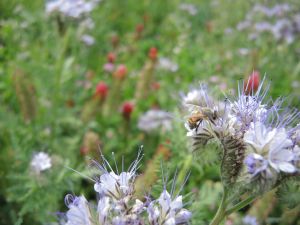 The PINEMAP Decision Support System is a new southern regional tool that launched earlier this year which uses climate data and pine productivity models to provide information on how the two interact. This tool is based on nearly 5 years of recent research and beyond that to more than 30 years of data on southern pine plantation management. Data from these studies are linked to state of the art climate models and specific location to allow the user to find out what environmental conditions are likely to be in the future, and how that may impact forest growth and productivity. Climate data is projected to the end of the century, but is broken up into 20 year time slices. So, for example, someone in Athens, GA could go to the tool to find out what summer precipitation conditions may be like from 2040-2060, or they may find out what what changes in temperature can be expected within that time period. Information which is very useful when planting trees with a 15-30 year harvest cycle. For more information go to http://climate.ncsu.edu/pinemap or contact Leslie Boby at lboby@sref.info.
The PINEMAP Decision Support System is a new southern regional tool that launched earlier this year which uses climate data and pine productivity models to provide information on how the two interact. This tool is based on nearly 5 years of recent research and beyond that to more than 30 years of data on southern pine plantation management. Data from these studies are linked to state of the art climate models and specific location to allow the user to find out what environmental conditions are likely to be in the future, and how that may impact forest growth and productivity. Climate data is projected to the end of the century, but is broken up into 20 year time slices. So, for example, someone in Athens, GA could go to the tool to find out what summer precipitation conditions may be like from 2040-2060, or they may find out what what changes in temperature can be expected within that time period. Information which is very useful when planting trees with a 15-30 year harvest cycle. For more information go to http://climate.ncsu.edu/pinemap or contact Leslie Boby at lboby@sref.info.
Author: Site Owner
Southeastern Regional Climate Hub Workshop presentations available now
 On January 20-21, 2016, The CLN hosted a virtual Mitigation and Adaptation Workshop with the USDA Southeastern Regional Climate Hub. The workshop featured experts in agriculture and forestry adaptation and mitigation practices. A major output of this workshop was the production of 16 climate specific webinars which will be available at climatewebinars.net. Climatewebinars.net is a new webinar portal which hosts a wide variety of topics concerning the effects of climate change on agriculture and forestry. With the addition of this content the site will have over 20 webinars to provide Extension Agents, ANR professionals, crop advisers and professional foresters with information to help them make climate smart decisions for their clients.
On January 20-21, 2016, The CLN hosted a virtual Mitigation and Adaptation Workshop with the USDA Southeastern Regional Climate Hub. The workshop featured experts in agriculture and forestry adaptation and mitigation practices. A major output of this workshop was the production of 16 climate specific webinars which will be available at climatewebinars.net. Climatewebinars.net is a new webinar portal which hosts a wide variety of topics concerning the effects of climate change on agriculture and forestry. With the addition of this content the site will have over 20 webinars to provide Extension Agents, ANR professionals, crop advisers and professional foresters with information to help them make climate smart decisions for their clients.
Whither be the drought?
As drought regimes change, the ability to quantify and predict the impacts on forests and rangelands is critical to developing and implementing management actions to increase resiliency and adaptation. So write our colleagues at the USDA Forest Service in their recently released report Effects of Drought on Forests and Rangelands in the United States: A comprehensive science synthesis. This peer-reviewed publication, a collaborative effort of 77 scientists, establishes a comprehensive baseline of available data that land managers can use to test how well their efforts to improve drought resilience and adaptation practices are working nationwide.

As Agriculture Secretary Tom Vilsack said upon announcing the report’s release “This report confirms what we are seeing, that every region of the country is impacted by the direct and indirect effects of drought conditions and volatile weather patterns.” Well, we knew that, didn’t we? The critical thing is to know how the various forest (and rangeland) processes will respond, allowing us insight into building resiliency. Key findings in the report include:
- Drought projections suggest that some regions of the U.S. will become drier and that most will have more extreme variations in precipitation.
- Even if current drought patterns remained unchanged, warmer temperatures will amplify drought effects.
- Drought and warmer temperatures may increase risks of large-scale insect outbreaks and larger wildfires, especially in the western U.S.
- Drought and warmer temperature may accelerate tree and shrub death, changing habitats and ecosystems in favor of drought-tolerant species.
- Forest-based products and values – such as timber, water, habitat and recreation – may be negatively impacted.
- Forest and rangeland managers can mitigate some of these impacts and build resiliency in forests through appropriate management actions.
Check out the full report or read the Executive Summary. And stay tuned, this spring the Climate, Forests and Woodlands COP will offer a webinar by James Vose, the report’s lead author. We will announce that webinar on this blog. Keep tending the forest…
The shocking truth about alternative energy!
If you want to save money switch to LED lighting, insulate your home and buy energy-efficient appliances. If you want to keep carbon dioxide out of the air the single biggest thing you can do is switch to alternative energy for your home. That’s the “shocking truth”. Why shocking? Because you never hear just how important that is. No other single thing you do as an individual will have as big an impact on climate change. Getting your home powered by alternative energy may seem like a daunting task, but really it could be as easy as a quick phone call or website Continue reading The shocking truth about alternative energy!
The post The shocking truth about alternative energy! appeared first on The Climate Advisor.
Oregon Forests and Climate Change
Occasionally we’ll use this space to tell you about other blogs we really like. This is one of those times. Oregon State University Forestry & Natural Resources Extension started a blog last year on Oregon Forests and Climate Change. Their goal is to assist Oregon’s private forest owners in understanding basic climate science principles, anticipated impacts on managed forests, and options for adaptation and management. We’ve just published a topic summary from the blog on the Climate, Forests and Woodlands Community of Practice site.

Extension specialists and agents from across the state are providing the science-based content and several articles have posted already. We expect that a lot of this valuable information is surely to be of interest beyond Oregon.
Check it out! blogs.oregonstate.edu/orforestscc/
California Regional Climate Sub Hub: Focus on drought in 2016
 The California Regional Climate Sub Hub (based at UC Davis) wrapped up its second year by co-organizing the Southwest Climate Summit in Sacramento, CA, on Nov. 2-3, 2015. The Summit included 250 attendees from state and federal government, academia, NGOs, consultancies, and stakeholder groups. The Summit used an interactive approach to explore how to use climate science in decision making and promote two-way conversations between scientists and stakeholders.
The California Regional Climate Sub Hub (based at UC Davis) wrapped up its second year by co-organizing the Southwest Climate Summit in Sacramento, CA, on Nov. 2-3, 2015. The Summit included 250 attendees from state and federal government, academia, NGOs, consultancies, and stakeholder groups. The Summit used an interactive approach to explore how to use climate science in decision making and promote two-way conversations between scientists and stakeholders. One of the Sub Hub’s new initiatives for 2016 is working with partner agencies to highlight field demonstrations of climate adaptation. For example, at the Plant Materials Center in Lockeford, CA (run by the USDA Natural Resources Conservation Service), cover crops take center stage. The Sub Hub will work with the PMC to create a series of educational materials for land users highlighting the ability of cover crops to survive drought, improve soil water-holding capacity, and increase infiltration rates. This aligns with the Sub Hub’s overarching theme of 2016: coping with California’s historic drought.
One of the Sub Hub’s new initiatives for 2016 is working with partner agencies to highlight field demonstrations of climate adaptation. For example, at the Plant Materials Center in Lockeford, CA (run by the USDA Natural Resources Conservation Service), cover crops take center stage. The Sub Hub will work with the PMC to create a series of educational materials for land users highlighting the ability of cover crops to survive drought, improve soil water-holding capacity, and increase infiltration rates. This aligns with the Sub Hub’s overarching theme of 2016: coping with California’s historic drought. Western Forest Health Workshops Announced for CA, ID and NM
NACD is working with the California, Idaho, and New Mexico state associations to conduct three forest health and wildfire listening sessions to help conservation districts share lessons learned and partnering ideas. Districts can discuss barriers and opportunities in working with state and federal agencies across jurisdictional boundaries to obtain healthy forests and watersheds. Districts can share their experience in working with private landowners and state and federal partners in pre-fire and post-fire mitigation and rehabilitation projects.
The California session will be held January 13, 2016 in Davis, CA. The Idaho and New Mexico dates are yet to be determined but the Idaho session is tentatively planned for March 1, 2016 in Boise, ID. The New Mexico event location and date will be determined soon so other western state conservation districts who want to participate will have options based on their schedules.
For more information contact Jeff Burwell, jeffburwell520@gmail.com,
NACD Western Issues Specialist.
from recent e-newsletter
NACD- National Association of Conservation Districts
CLN To Host Southeast Regional Climate Hub Virtual Workshop on Agricultural Solutions Jan. 20-21
 This virtual Southeast workshop will focus on adaptive strategies that make working lands more resilient to an increasingly variable climate, while at the same time mitigating greenhouse gas emissions. State and federal programs that support these efforts will be highlighted, along with tools for improving resilience and communication.
This virtual Southeast workshop will focus on adaptive strategies that make working lands more resilient to an increasingly variable climate, while at the same time mitigating greenhouse gas emissions. State and federal programs that support these efforts will be highlighted, along with tools for improving resilience and communication.
In an effort to be more inclusive and respect the tight travel budgets of many organizations, SERCH decided to make our Greenhouse Gas Mitigation Workshop a  virtual event instead of an in-person one. The workshop, which was originally scheduled for November 17-18, will be moved to January 20-21. The workshop will have an agenda of fantastic speakers, but without the cost and carbon emissions of an in-person workshop. Register at serch.us/workshop, and contact Sarah Wiener (sswiener@ncsu.edu) with any questions. View the flyer here.
virtual event instead of an in-person one. The workshop, which was originally scheduled for November 17-18, will be moved to January 20-21. The workshop will have an agenda of fantastic speakers, but without the cost and carbon emissions of an in-person workshop. Register at serch.us/workshop, and contact Sarah Wiener (sswiener@ncsu.edu) with any questions. View the flyer here.

Seeing the Future of Southern Pine (among other things) from your Desktop
The PINEMAP (Pine Integrated Network: Education, Mitigation and Adaptation Project) Team recently announced a new tool release. The PINEMAP decision support system (DSS) is a map-based collection of climate and forest productivity web tools designed to provide region-wide information on likely future climate risks, opportunities, and impacts on southern pine at a watershed-scale.
DSS tools transform output from PINEMAP research into an easy-to-use visual framework. The intent is for professional foresters and clients to make informed land management decisions based on best available science into the near and distant future.
While the tools were developed with applications to professional foresters in mind, several of them may be useful for making other weather and climate sensitive decisions. All tools were developed through extensive beta testing, workshops, and meetings where interaction, improvements and suggestions were solicited among scientists and stakeholders.
The DSS is now publicly available at: http://climate.ncsu.edu/pinemap/
Currently, PINEMAP’s DSS contains tools that display information on a range of possible future climates at local scales, including extreme temperatures and seasonal precipitation, and provide guidance for selecting and marketing seedlings. Future tools will be added as research outputs become available.

The image above depicts the historical and projected average minimum temperature on the coldest day of the year for a user defined (lat./long) location south of Raleigh, NC. The multi-model mean (center screen) is the average of 20 different downscaled global climate models and the highest and lowest likely temperature screens to the sides reflect +/- 2 standard deviations from the mean. The graduated color scheme reflects 20-year slices out into the future (until end of century). Cooler colors represent close future projections (e.g. 2010-2029 and 2020-2039) while warmer colors reflect projections closer to the end of century (e.g. 2060-2079 and 2080-2099). Users can select among the three screens to zoom to a location of interest.
But Wait! There’s More
DSS tools coming in spring / summer 2016 include:
- growing season length
- drought and flood risk
- forest productivity model outputs, such as:
- gross and net primary productivity
- net ecosystem productivity
- merchantable volume
- carbon above ground
- water stress
Check out the newly released website and contact the State Climate Office if you have any questions or tool suggestions!
This post contributed by Heather Dinon Aldridge, Corey Davis and Ryan Boyles of the NC State Climate Office.
Sylvia Earle, my new favorite scientist; and other tidbits
Sylvia Earle I was recently listening to the ClimateOne podcast, one of the best podcasts about climate change out there. They were interviewing Dr. Sylvia Earle, a famous oceanographer and outspoken advocate for the world’s oceans, about the decline of the worlds oceans. She has been an oceanographer for some time, and is a pioneer in the field for women, and in general. She was formerly NOAA’s Chief Scientist, among many other accomplishments, and is a National Geographic Explorer in Residence. She’s very well spoken and really brings home the huge declines that have occurred in the world’s oceans due to human Continue reading Sylvia Earle, my new favorite scientist; and other tidbits
The post Sylvia Earle, my new favorite scientist; and other tidbits appeared first on The Climate Advisor.

